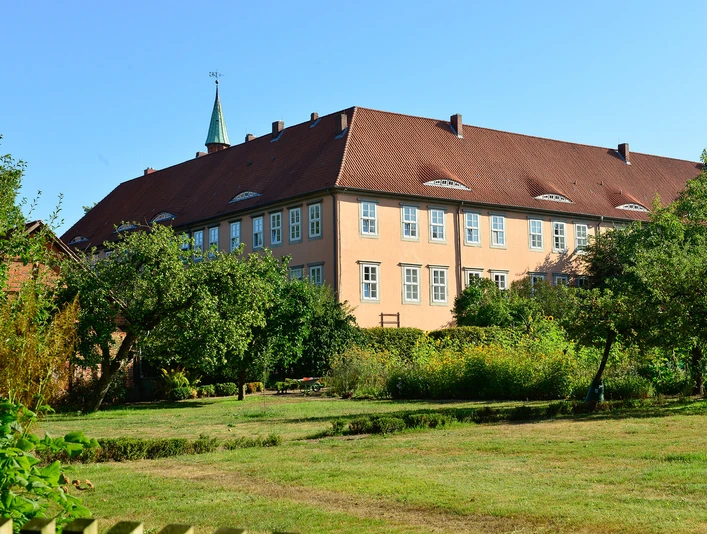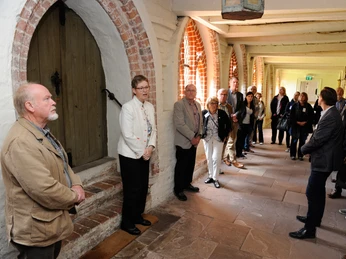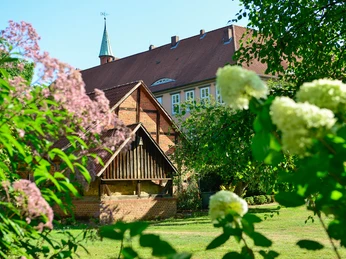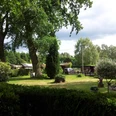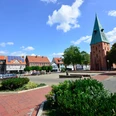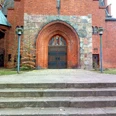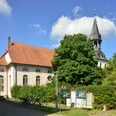- Photos & Map
How would you like to arrive?
- Call
- Description
- Good to know
- Nearby
This interplay provides an authentic insight into the processes and customs of former convent life that is well worth seeing. In the textile exhibition, visitors can marvel at artistic monastic embroidery, including river pearls from the Südheide Gifhorn region.
Duchess Agnes, born Margravine of Landsberg from the House of Wettin, founded a Cistercian monastery in 1243 to provide spiritual care for the nearby Wienhausen Monastery. However, the monks left the monastery as early as 1259 after a fire. In 1265, the monastery was revived with Cistercian nuns. In 1327, it was moved from Alt-Isenhagen to Hankensbüttel to the existing archdeaconry church. The rebuilding of the monastery began in 1345, but soon came to a standstill due to the outbreak of the plague.
The first decades of the 16th century were an economic heyday for Isenhagen Monastery. The sovereign's demands for money and the upheavals brought about by the Lutheran Reformation from 1527 put an end to this phase. When Dukes Ernst and Franz demanded the return of the seals, documents and jewels, the abbess, prioress and chapellain moved the archives to Halberstadt in 1540. In the same year, the first Protestant head of the convent, Judith von Bülow, was appointed. This made Isenhagen the first of the Lüneburg nunneries in which the Reformation was officially introduced.
The nunnery developed into a Protestant convent that retained its traditions for a long time: as late as 1619, the Protestant convent rules contained explicit provisions on enclosure and regular prayer times. Until the late 17th century, the monks continued to eat together at long tables in the refectory and read the Bible at the same time. The monastic prayer times were reduced in number over time, but continue to exist to this day.
After the Second World War, the monastery offered refuge and accommodation to refugee families up to its capacity limits, sometimes until the mid-1950s.
See
Church and cloister were built from 1345 in the North German Brick Gothic style and completed before the outbreak of the plague. The rebuilt convent buildings of the 18th century were executed in simple Baroque half-timbered architecture. In the inner courtyard, the two architectural styles that meet here are striking.
Special gems are the altars in the parish church and on the nuns' choir, the former throne seat of the founder, which was converted into a lectern in the following centuries, as well as the limestone consoles in the east cloister with corresponding scenes from the Old and New Testaments facing each other.
Today's use
Through the centuries, single women have lived as conventuals under the direction of an abbess in the Protestant Isenhagen Monastery, which is an independent public corporation and is under the legal supervision of the President of the Hanover Monastery Chamber in his capacity as state commissioner.
- Built around 1345 on its current site
- Converted into a Protestant convent after the Reformation in 1540 and still inhabited by women over the centuries
- Church with a nun's choir and two carved Gothic winged altars
- Cloister with limestone consoles
- Museum with precious textiles, precious goldsmith's work and rare books
Guided tour of Isenhagen Monastery
Themed class excursion "Being a monk in a monastery for once"
Book tips on Isenhagen Monastery:
Poneß, Kirsten: Kloster Isenhagen. - Deutscher Kunstverlag - (DKV art guide no. 678)
Tribian, Henning (2020): Isenhagen pilgrimage trail. In the footsteps of the Cistercian nuns. Forays in the southern heath. (CALLUNA Verlag Menschen und Medien, Gifhorn-Oerrel-Uelzen)
Tribian, Henning (2014): Kloster Isenhagen - Heimatkundliche Bedeutung von der Gründung bis zur Reformation. (CALLUNA Verlag Menschen und Medien, Gifhorn-Oerrel-Uelzen, ISBN 978-3-944946-01)
Good to know
Openings
Tuesday to Sunday 14:30 - 17:00
Public holidays: 14:30-17:00
Last admission always at 16:30
As the monastery is inhabited, it can only be visited as part of a guided tour.
Price info
Price adult: €5.00
Price reduced: €2.00
Gruppen ab 20 Personen: €4.00
Eligibility
Bad Weather Offer
Suitable for any weather
for Groups
for Class
for individual guests
Suitable for the Elderly
for Children of all Ages
Other Furnishing/Equipment
Toilet
Author
Organization
Südheide Gifhorn GmbH
License (master data)
Südheide Gifhorn GmbH
Nearby
